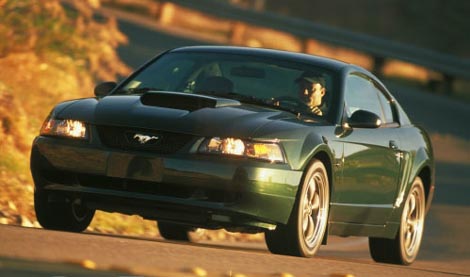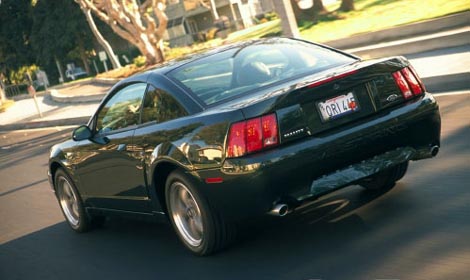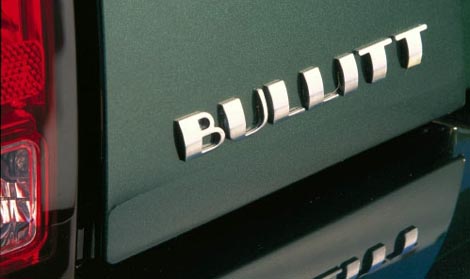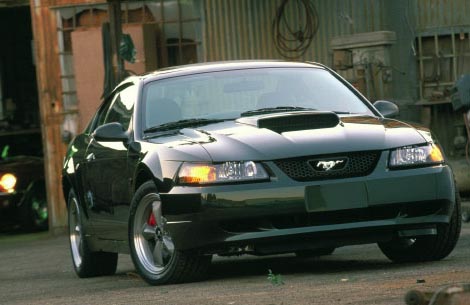


No, you're not in a time warp. The Featured Car this month is, once again,
the Bullitt Mustang. Back in April of 2000, when ICMC opened its web site,
the first Featured Car was a concept vehicle modeled after the 1968 GT
Fastback driven by Steve McQueen in the 1968 movie "Bullitt." At that time,
the car was only a concept. Well, on January 4, 2001, Ford announced it will introduce the 2001 Mustang Bullitt GT, a performance derivative inspired by the legendary 1968 Mustang Fastback that co-starred with Steve McQueen in the classic Warner Bros. Pictures film, "Bullitt." The decision to put the Bullitt into production came after Ford received overwhelming positive response from consumers who first saw a concept version of the car at the 2000 Los Angeles Auto Show. "The movie has some of the greatest car-chase scenes ever filmed," says Ford Division President, Jim O'Connor. "The 1968 Fastback Mustang GT 390, driven by Steve McQueen, created an indelible image in the minds of millions of people. We have taken some of the passion from the Hollywood film and put it into an exciting new car." The 2001 Bullitt features exterior enhancements that visually and emotionally connect it to the 1968 Fastback from the film. These modifications include unique side scoops, 17-inch Bullitt-style aluminum wheels and a lowered suspension. The C-pillars and quarter panel molding have been modified to create a unique look. Rocker-panel moldings enhance the low-to-the-ground appearance. A bold, brushed aluminum fuel filler door is prominently placed on the quarter panel. Bullitt badging and polished-rolled tailpipe tips further distinguish the car. Bullitt is available in Dark Highland Green, True Blue and Black.  The heart of Bullitt GT is a 4.6L SOHC V-8 modified to improve airflow and reduce parasitic loses. It produces at least 270 horsepower and significantly more torque than the Mustang GT engine. Modifications include: twin 57mm bore throttle body, cast aluminum intake manifold, high flow mufflers for increased power and aggressive performance sound, and optimized alternator and pump pulley ratios. Bullitt's suspension translates this power into crisp road manners. The vehicle is lowered three-fourths of an inch to generate a firmer, better-balanced ride and improved handling characteristics. The performance-handling package includes: re-valved Tokico struts and shocks, unique stabilizer bars (front and rear), frame rail connectors, and thirteen-inch Brembo front rotors and performance calipers provide excellent stopping capability. The calipers are painted red and are visible through the 17-inch wheels spokes when the car is parked or when it is cruising the streets of San Francisco. "Bullitt is quick off the line, handles great, stops fast and shifts easily with improved pedal relationship," says Art Hyde, Mustang chief program engineer. "This is the best performing GT we have ever produced." Inside, Bullitt features performance bucket seats with Dark Charcoal leather trim. A brushed aluminum shifter ball, shifter bezel, door sill plates with Bullitt nomenclature and aluminum pedal covers accent the interior's performance appearance. The instrument cluster is a modern interpretation of 1960s design and offers unique curved numeric speedometer graphics and a white-lit background. "With the Mustang Bullitt, we have a lot of functional features that would make Steve McQueen and Lt. Frank Bullitt proud today," says O'Connor. "Bullitt has elevated the GT into an unforgettable car that enhances Ford's performance reputation and builds on Mustang's performance tradition that began with vehicles like the Mach 1, Boss 302 and the 428 Cobra Jet." All these features are included for a package price of $3,695 MSRP. There will be a limited production of about 5,000 Mustang Bullitt GTs built on the same line of the Dearborn Assembly Plant that produces the V6, GT and Cobra Mustangs. Each Bullitt will come with a unique serialized identification label from the factory to ensure exclusivity and collectability. Ford marked Mustang's 35th anniversary in 1999 with across-the-board improvements, including major styling, powertrain and handling upgrades. Increases in horsepower and torque gave more muscle to both the V-6 and V-8 engines and reduced 0-60 mph and quarter-mile acceleration times.  The exterior design harkens back to the concept of the original pony car, with styling cues like the classic long hood and short deck; a prominent hood scoop; enlarged, sculptured side scoops with a bold triangular shape; and the vehicle's signature tri-bar taillamps. Mustang enthusiasts recognize familiar details like the rear spoiler, honeycomb grille textures, and side character lines. In 1997, Ford of Europe launched its new Puma with an advertising campaign built around the Bullitt chase scene. Its agency, Young and Rubicam, spent six days in San Francisco filming the Puma in various locations. At the end of the 60-second spot, the Puma is backed into a garage next to Kunz's Mustang. In the finished commercial, McQueen's image is digitally imposed into the Puma as if he were driving the car. The Mustang returned to San Francisco in 1999, this time as part of a European automotive media event to launch the Puma. Ford photographed the Mustang and Puma together at various locations in the city to continue the Bullitt theme that is now associated with Puma all over Europe. WHERE IS THE REAL BULLITT MUSTANG? For the filming of "Bullitt," two 1968 Mustang Fastbacks were used from the Warner Brothers fleet for actor Steve McQueen's movie character. Once the Mustangs were selected, veteran race driver and builder Max Balchowski was enlisted to modify the cars for the rigors of the high-speed pursuit scenes. Balchowski added stronger springs and Koni shocks, and he fabricated braces for the inner fenders. He also did some minor tuning to the 390-cubic-inch engine for a little more top-end power.  After filming was completed, the primary car was in sad shape. Two weeks of stunt driving had taken its toll on the Mustang, so it was sent to the crusher due to liability concerns. The remaining car, the less-damaged backup, was sold to an employee of Warner Brothers' editing department. In the early 1970s, the car was advertised in a classified ad in The Los Angeles Times for the then princely sum of $6,000. A buyer was found and the car eventually made its way to the East Coast. The Mustang went up for sale again in 1974, this time in an ad in Road & Track. It is reported that Steve McQueen himself called the New Jersey number in the ad with a desire to purchase the car for his own collection. He was told the car had been sold, but was given the name and number of the buyer. McQueen tried to persuade the new owner to resell it, but to no avail. The new owner did promise to contact him if he ever did decide to sell. McQueen died in 1980 with no contact from the owner. Whenever contacted by prospective buyers or media, the owner has refused offers of purchase or publicity. The car has been in non-running condition for some time. The car remained in New Jersey until the mid-1990s, when it was moved to a farm in Ohio. Parked in a hay barn, the Mustang remained inoperable, still wearing New Jersey tags. A film company recently made an offer to the owner for its use in a motion picture. The owner declined.  View Previous Featured Cars Copyright © 2002 Island Classic Mustang Club. Last modified Friday, 26-Jan-2001 12:49:47 PST. |

 Email this URL
Email this URL